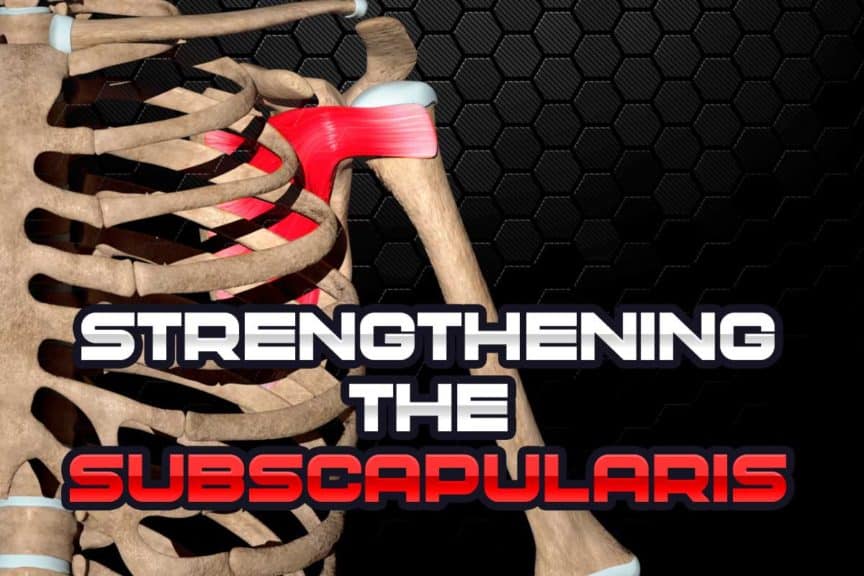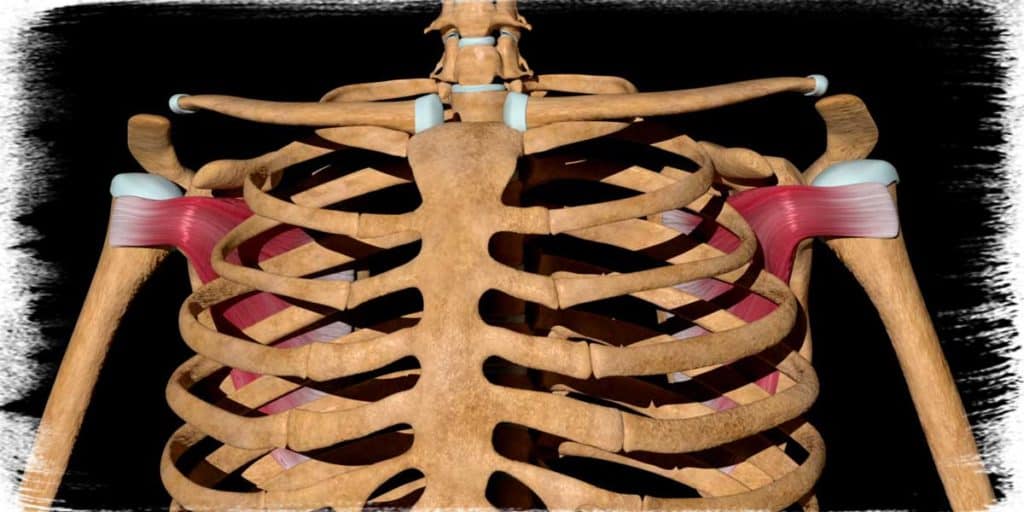While different exercises can be performed to help strengthen the subscapularis muscle, many of them don’t isolate it effectively, which minimizes the work that this muscle has to do throughout the movement. This leads to other similar muscles doing the majority of the work while reducing the strengthening effect of the subscapularis. If you need an exercise that ensures you’re isolating the subscapularis to the greatest extent possible, this article has you covered!
The best subscapularis strengthening exercise is the Resisted Kinetic Medial Rotation Test (KMRT). When performed correctly, it has the ability to target the subscapularis muscle without additional input from other medial rotator muscles such as the pectoralis major or latissimus dorsi.
There are some very critical pieces of information that you’ll want to know with this exercise if you want to have supreme confidence in knowing (and feeling) that your subscapularis is doing the majority of the work with this movement, so be sure to keep on reading to learn the details!
ARTICLE OVERVIEW (QUICK LINKS)
Click/tap on any of the following headlines to instantly jump to that section of the article!
What is the KMRT?
Quick anatomy: The role & function of the subscapularis
Setting up for the resisted KMRT exercise
Performing the general movement
How to ensure isolation of the subscapularis
Final thoughts
Related article: Foam Rolling Your Pecs: A MUCH More Practical & Effective Way
What is the KMRT?
As a relatively quick background, the Resisted Kinetic Medial Rotation Test (KMRT) is a clinical test that measures some unique aspects of an individual’s movement abilities around the shoulder joint. While the specifics are far outside the scope of this article, the KMRT can be used to help assess an individual’s movement control and quality around their shoulder, which, when identified and addressed, can be a game-changer with helping individuals overcome various shoulder issues.
Here are some neat articles that describe the KMRT in more detail:
- Inter-rater and intra-rater reliability of a movement control test in shoulder
- Scapular positioning and motor control in children and adults: A laboratory study using clinical measures
For the strengthening exercise in this article, we are going to mimic the motion of the test while adding some gentle resistance to the movement (using a Theraband). When performed correctly, it will challenge the subscapularis muscle in an effective manner, providing a physical stimulus to the tissue, helping it adapt in contractile strength and overall functional ability.
Related article: Ten EPIC Benefits of the Functional Movement Screen (Science-Proven)
Quick anatomy: The role & function of the subscapularis
The subscapularis is one of four muscles that comprise the rotator cuff. It’s unique from the other three muscles in that it’s the only one of these muscles that stabilizes the glenohumeral joint (the shoulder joint) from the front rather than the back.
The role of this muscle is to produce internal rotation of the shoulder joint while adding stability to the joint overall. The subscapularis (along with the other three rotator cuff muscles) are smaller muscles that work to fine-tune movements of the shoulder as it moves from position A to position B.
Larger, more powerful muscles such as the pectoralis major and the latissimus dorsi (among others) work to produce the big, broad movements that the shoulder undergoes as it moves from position A to position B. Still, it’s up to the rotator cuff muscles (which are much smaller and much more delicate) to fine-tune the movement from one position to the other.
This will be important to be aware of, as this resisted KMRT exercise will require you to make sure that the big, powerful muscles are “shut off” throughout the exercise to maximize the amount of work/effort that the subscapularis muscle must produce to complete the movement.
Setting up for the resisted KMRT exercise
To set up for this exercise, you will need:
- A piece of Theraband of appropriate resistance (usually light-to-medium)
- An anchor point directly behind you for the band
- A bolster or other comfortable, supportive structure for your arm
- A pillow for comfort of your head and neck (optional)
Lay in front of the band’s anchor point and prop your elbow up on the bolster with your elbow out to the side of your body (approximately 80 or 90 degrees). The support surface that you rest your elbow on should be about chest high, as this helps to align the arm in a manner that forces the subscapularis muscle to produce most of the effort (provided you adhere to the rest of the rules below).
It is often much more challenging to get the subscapularis to do the majority of this exercise if the arm is simply resting on the ground.
Performing the general movement
To perform the movement, rotate your arm downwards while keeping your elbow bent to 90 degrees. Do this slowly and against the amount of resistance that feels appropriate for you.
Here’s the first “secret sauce” tip of performing this exercise: Only rotate your arm down as far as you can UNTIL you feel like your shoulder wants to move forwards/”pop upwards.” If you feel your shoulder doing even the slightest bit of this, you’ve gone too far.
The average amount of internal rotation of the shoulder joint (the motion of this exercise) is approximately 70 degrees, so you won’t be able to take your forearm parallel to the ground.
Once you’ve gone as far as you can, slowly return to the starting position and repeat for as many repetitions as needed.
How to ensure isolation of the subscapularis
Here’s the second “secret sauce” tip of performing this exercise: You need to keep your pectoral muscle and latissimus dorsi muscle soft to ensure that most of the work is placed on the subscapularis muscle.
The pectoralis major and the latissimus dorsi are powerful internal/medial rotators of the humerus (upper arm bone). If these muscles are tightening up (contracting) during the movement, they are doing more of the action than the subscapularis.
Speaking in a functionally-based manner, big powerful muscles such as the pectorals and the latissimus working to produce internal rotation is a very good thing. However, for rather specific, therapeutic rehabilitation or clinically-based strengthening of the subscapularis, we don’t want these big, powerful muscles to do any of the work; we want the subscapularis to take the lead.
This ability to keep other muscles from engaging during the exercise is known as dissociation of movement. When the brain learns how to dissociate movements better, it can help to drop unwanted muscle tension and emphasize the recruitment of different muscles (such as the subscapularis, in this case) instead.
How to keep the pectoral muscle from performing the movement
It can take practice to be able to keep your pectoral muscle from firing when performing this exercise, but it’s absolutely worth it.
The pectoral muscle should stay loose and relaxed throughout the entire movement; if it tightens up at any point, it’s trying to produce the movement of the arm.
Here’s how to make sure you’re not using your pectoral muscle for the movement:
- Place your free hand on the outer part of your chest (this is where the pectoral muscle fibers converge as they make their way to attach to the humerus.
- Make sure this muscle is soft and “loose” before the movement starts.
- Next, rotate your arm downwards while feeling for any increase in tension of the pectoral muscle with your free hand.
- If you feel an increase in tension, start over and try again. It takes practice, but your subscapularis will get rather tired as it no longer gets help from the powerful pectoral muscle.
How to keep the latissimus muscle from performing the movement
The other powerful muscle that can help rotate the arm internally (downwards, in this case) is the latissimus dorsi, a powerhouse of a muscle for producing arm movements.
It needs to stay whisper-quiet, just like the pectoral muscles when performing this exercise.
Here’s how to make sure you’re not using your latissimus muscle for the movement:
- Place your free hand across your body and towards the backside of your ribs. It helps to push your fingertips into this muscle to feel it better.
- Hold your fingers there as you then produce the downward rotation with your other arm.
- If the latissimus tightens up, your brain is trying to use this muscle to produce the movement (which is normal, but for this exercise, you need to get good at telling your brain not to use this muscle).
Final thoughts
If you need an exercise that can adequately target the subscapularis muscle in order to give it an effective stimulus for strengthening, the Resisted Kinetic Medial Rotation exercise is likely the one.
This exercise does not require any specialized equipment, and it can be performed nearly anywhere, making it a great option to go to when wanting to isolate movement to the subscapularis.
Just make sure that you’re not bringing other muscles into the movement when performing the exercise. The more the other muscles want to “help out,” the less work the subscapularis will be required to do, making the strengthening intervention less effective overall.
Now, go give it a try and strengthen your subscapularis!

Hi! I’m Jim Wittstrom, PT, DPT, CSCS, Pn1.
I am a physical therapist who is passionate about all things pertaining to strength & conditioning, human movement, injury prevention and rehabilitation. I created StrengthResurgence.com in order to help others become stronger and healthier. I also love helping aspiring students and therapists fulfill their dreams of becoming successful in school and within their clinical PT practice. Thanks for checking out my site!









